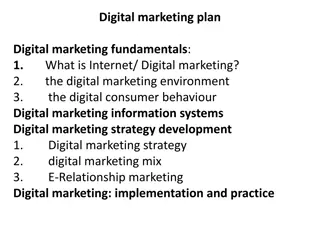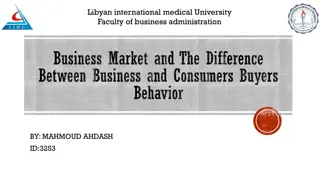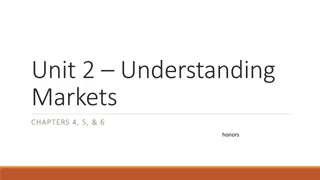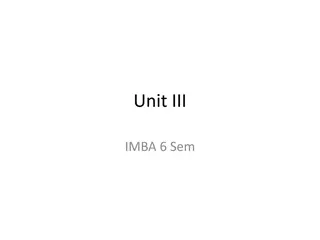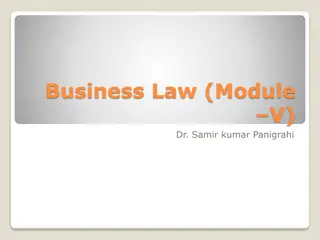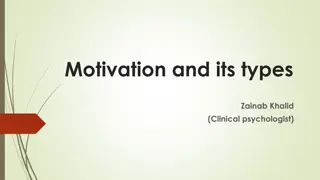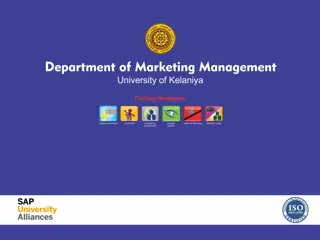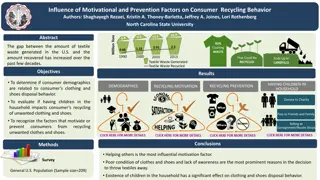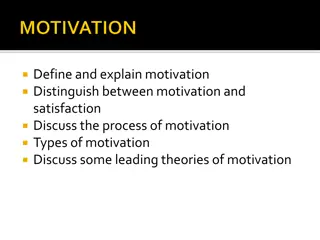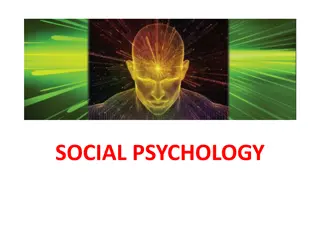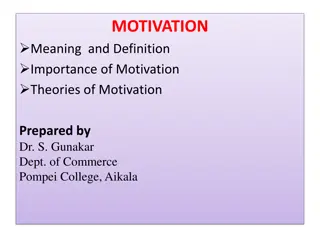Understanding Consumer Behavior and Motivation in Purchasing Decisions
Consumer behavior refers to the process where individuals make decisions on purchasing goods and services. Motivation plays a crucial role in driving individuals to take action towards fulfilling their needs and desires. This motivation arises from a state of tension caused by unmet needs. Different types of needs, both primary (innate) and secondary (acquired), influence consumer behavior. Goals act as the results of motivated behavior, shaped by personal experiences, physical capacity, and cultural norms.
Download Presentation

Please find below an Image/Link to download the presentation.
The content on the website is provided AS IS for your information and personal use only. It may not be sold, licensed, or shared on other websites without obtaining consent from the author. Download presentation by click this link. If you encounter any issues during the download, it is possible that the publisher has removed the file from their server.
E N D
Presentation Transcript
Presented by Dr. Anubha Vikram University Presented by Anubha Gupta University Dr. Gupta Faculty , S.S. in Commerce Useful for BBA(H)/B.COM(H)/M.COM and allied subject Faculty , S.S. in Commerce Vikram Useful for BBA(H)/B.COM(H)/M.COM and allied subject
Consumer behavior may be defined as the process whereby individuals decide whether , when, where ,how and from whom to purchase goods and services.
The ability to buy something, The opportunity to buy it The motivation
A person is said to be motivated when his or her system is energized (aroused), made active and behaviour is directed towards a desired goal . Motivation is the driving force within individuals that impels them to action. This driving force is produced by a state of uncomfortable tension, which exists as the result of an unfulfilled need.
We all have needs, wants and desires. The drive to reduce need-inducted tension results in behaviour that we anticipate will satisfy needs and thus bring a more comfortable state.
A.PRIMAY air, shelter or sex, etc. it is also called innate or physiological needs. B.SECONDARY for power, for affection, for prestige. It is also called acquired needs . We learn this needs from our environment or culture A.PRIMAY NEEDS NEEDS: which include food, water, B.SECONDARY NEEDS NEEDS: These may include need
PHYSIOLOGICAL NEEDS SECURITY NEEDS NEED FOR LOVE & BELONGINGNESS ESTEEM NEEDS SELF ACTUALISATION NEEDS
All behaviour is goal-orientated. Goals are the sought-after results of motivated behaviour. The form of direction that behaviour takes the goal that is selected is a result of thinking process and previous learning. The goals selected by individuals depend on their personal experiences, physical capacity, goal s accessibility in the physical and social environment and above all the individual s cultural norms and values.
Generic goals Product specific goals Brand specific goals Store specific goals
A motive may be defined as a drive or an urge for which an individual seeks satisfaction. It becomes a buying motive when the individual seeks satisfaction through the purchase of something. ..W.J. Stanton
Physical , psychological and sociological motives Acquired or inherent motives Product & patronage motives Primary & selective motives Conscious & Dormant motives Rational & Emotional motives
Needs are never fully satisfied. Success and failure influence goals. Needs and goals are constantly changing. Consumer have multiple needs. Motives are difficult to infer from behavior. Motives can be aroused in many ways. Consumer are aware for their goals than their needs.
https://www.yourarticlelibrary.com/consume r-behaviour https://www.dlmmarketing.com.au/motivatio n

 undefined
undefined








